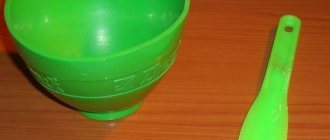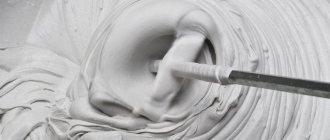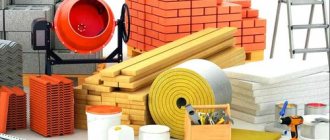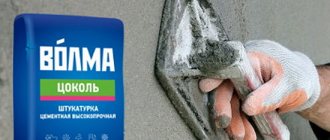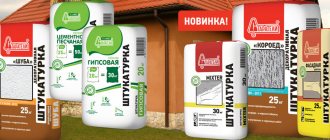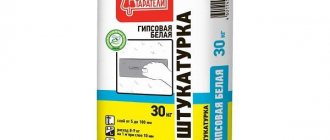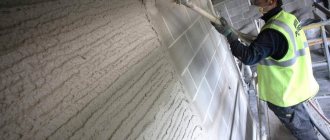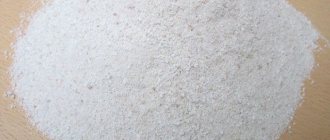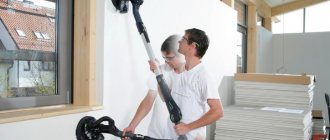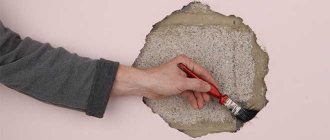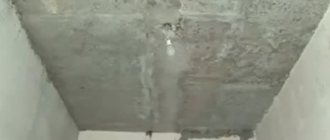The store advised me to buy the famous Rotband plaster, but it immediately hardens after mixing. Why is this happening?
Plaster, or rather plaster prepared from a ready-made gypsum mixture (as people say, just add water) and it doesn’t matter whether it’s “Rotband” or some other brand of plaster can immediately harden after mixing! - in only one case this is:
Expired/Expired expiration date/freshness of the mixture - and nothing more, you can’t add here, they just slipped you an expired product, or you already had it sitting around for quite some time before they started using it!
Judging by the description in question, you bought an openly “leftist” Rotband (that is, there are a lot of fakes on the market).
But the kneading technology may have been violated, or rather the proportions have not been met.
10 kg of Rotband requires 6.5 liters of water.
First, pour water into the container (but not all of it, leave not most of it), then add Rotband and stir with a drill and whisk.
At the finish, add the remaining water.
If you are afraid of making a mistake with the proportions, you can use measuring containers.
Perhaps you don’t have enough water and the Rotband is seizing.
Perhaps you knead in large quantities and by hand (with a trowel), without having time to mix, Rothband seized.
The word “immediately” is almost counterintuitive, the fact is that Rothband “lives” after the kneading for about 20 minutes, 3-0, perhaps you just don’t have time to work out the entire knead.
You may have bought Rotband with a torn bag; it is a dry gypsum mixture and it absorbs moisture very quickly.
Perhaps the shelf life of "Rotband" has expired.
Immediately after mixing, the Rotband plaster mixture can set for several reasons:
- The proportion of water and dry mixture is not observed. According to the instructions, you need to add about 2 parts of water to 3 parts of the dry mixture; to be precise, a 30-kilogram bag will need 18 liters of water. If there is not enough water in the mixed solution, it begins to heat up quickly and harden immediately after mixing;
- Unclean dishes or water were used for kneading. The prepared mixture “lives” for about half an hour and after that the setting process begins. If there are remnants of the previous batch in the mixing container and more than half an hour has passed, then a chemical reaction begins in the new solution already during ripening. Also, the reason for rapid setting may be the use of hot water for kneading or any additives;
- improper storage or expiration date. The dry mixture should be stored in sealed bags, on wooden pallets, in a dry place. Subject to these standards, Rotband should be stored for no more than 6 months. If the packaging is damaged or there is high humidity in the room, the shelf life of the plaster is reduced;
- counterfeit goods. Rotband plaster is so popular that it is often counterfeited; even the manufacturer is forced to use holographic stickers on its packaging for protection, but this does not stop “businessmen.”
Because You are not logged in. To come in.
Because The topic is archived.
Why can't it be used in wet areas?
Wet areas include kitchens and bathrooms. Even some manufacturers indicate this on their products, warning the buyer in advance. This kind of relieves them of responsibility so that people don't come and complain. The fact is that this material is capable of absorbing moisture. If there is not enough of it in the room, then the absorbed moisture quickly evaporates from the plaster. But if high humidity is maintained constantly, the condition of the gypsum deteriorates. This can cause it to peel and collapse, especially if there are heavy tiles attached to the top. It is for these reasons that it is not recommended to use it in such rooms.
Announcements on NN.RU - Business
Equipment machine for dry cleaning of potatoes and vegetables MSO-16 – designed for cleaning vegetables from soil and black soil.
Welded PM body assembly (PM disker hub) from the manufacturer, the cutting unit of the modernized disk harrow is used on. Price: 2,500 rub.
Suitable for Kitagawa, Samchully, AutoGrip, AutoStrong, Seoam, Tonfou, Chandox, Howa chuck Height 36 mm Similar to HC-06, KSJ6 jaws. Price: 1,625 rub.
Umbrella materials: stainless steel of various thicknesses, galvanized or other similar metals. For example: Ots 1000x700, height 400. Price: 2,000 rubles.
Black, stinking geysers that appeared on the Volga last weekend near Balakhna alarmed Nizhny Novgorod residents. Everyone understands that ours.
Repair is a real challenge for a family. A hundred questions arise that have no answers, and a lot of problems that are urgently needed.
September decided to pamper Nizhny Novgorod residents with warm weather, and Instagram accounts were full of truly autumn shots. Every shot.
Monday morning began with a major accident in the Prioksky district - on Larina Street, a heavy truck loaded with either coal or hot coal.
Advantages
is a popular manufacturer because the quality of its products justifies itself. The company offers a wide range, including several types of mixtures.
Read also: Desserts made from... zucchini
All brand putties have the following advantages:
- Environmentally friendly product. The building material can be used to level walls in different rooms, including a children's room. Its composition is completely free of harmful components.
- The mixture is airy and plastic. Working with putty is a pleasure because leveling is very quick and easy.
- Putty gives the surface a beautiful appearance. There is no need to additionally use the finishing mixture.
- After using the building material, shrinkage does not occur.
- The material is characterized by its ability to thermoregulate.
- To level the wall, it is enough to use only one layer, which usually does not exceed a thickness of more than six centimeters.
- The material is characterized by its ability to thermoregulate.
- The mixture is durable, it also hardens quickly, which has a positive effect on the durability of the coating.
- The material can be used on various surfaces.
- The inexpensive price of dry mixtures and their long shelf life allows you not only to choose a budget option, but also to use the remainder of the mixture in the future.
Tools and containers
First, we will list the tools and accessories, then we will analyze the details.
You will need:
- Master OK;
- mixer;
- spatulas (2 different widths);
- containers (for mixing, water, washing tools);
- wide brush for washing tools and dishes;
- scales, measuring container.
Let us immediately note several nuances of the mixing process related to the container. Today's utensils are made of plastic. A container made of soft plastic will withstand numerous cycles of mixing and production longer.
The container volume is selected depending on the number of plasterers directly involved in applying the plaster, their experience, as well as the volume of mass required for repairs. If you only need to plaster a small area, you can use a plastic paint bucket for preparation. If a beginner is plastering, then a 60 liter basin is enough. A professional will be able to produce a large volume (90 liter container) before setting begins.
In order for a plastic basin to last longer, it is recommended not to carry it along the floor, but to rearrange it by lifting it (it is advisable to take it together, then the container will not deform under the weight of the plaster when lifted).
You can also strengthen the walls of the pelvic bowl by wrapping it with several layers of tape.
Before mixing, the floor surface under the basin is cleared of debris (must be level), and near the wall it is better to place a basin filled with solution on a bag with SS.
Gypsum is a capricious material and sets quickly. The lifespan of a solution may vary for various reasons. If a lump of the solution that has begun to harden gets into the plaster dough, crystallization centers will form ahead of time. For this reason, you cannot add dry mixture to a ready-made solution.
The beginning of setting of the solution is accelerated when using a dirty tool, dirty bucket or other container. Tools must be washed regularly before the plaster on their surface hardens; after finishing work, they must also be washed and dried.
Instead of a mixer, you can use a drill equipped with an attachment. Practitioners do not recommend using a mixer with two whisks. Such a tool generates more dust, and after a whisk breaks, buying a new one is a problem. Whisk rotation speed – no more than 800 (optimally – 600) rpm.
The temperature of the utensils and tools used is room temperature (not lower than +5, not exceeding +30°C).
Technology of working with gypsum plaster
The beacon alignment technology comes down to the following. Step 1. Mark the wall using a level. Step 2 . We draw vertical lines at a distance of 0.8 meters. Step 3. Draw blots from the rotband along the lines. Step 4 . Now we install beacons on them. Their height is the thickness of our solution. Step 5 . We straighten them exactly to the level. Step 6 . We begin to throw the prepared solution onto the wall or apply it with a trowel. In this way, we process the distance between the beacons to a height of about a meter. Then we take the rule (in our case its length is approximately 1 meter 20 centimeters) and stretch out the plaster. Step 7 . We remove the excess mixture with a spatula and apply it either to the scratches or higher on the wall. For work at heights higher than your height, we use a small stepladder. Step 8 . Having aligned our wall in this way, we move to the next lighthouse. We work in the same way.
Preparation of working solution
Knowledge of how long it takes for Rotband plaster to dry will also be useful in the process of mixing the composition for work. Since the mixture sets quickly enough, it does not need to be prepared in large quantities. Dilute as much dry powder as you can use within 30 minutes. After this time, the plaster will begin to set and it will be quite difficult to apply it to the walls.
To prepare the mixture, use 3 parts water and 2 parts dry mixture. First, pour water into the bucket, then gradually add the powder and begin kneading the composition using a construction mixer.
Note! The colder the water, the longer the plaster hardens.
Why does TEPLON plaster mixture set quickly?
The best option is when there is preliminary putty. 3. Priming the base before each stage. The absorption of the base is reduced, the mobility of the mixture on the wall is maintained, and the consumption of the mixture is reduced. 4. Expensive putty is better than cheap one. Truth that comes with experience. 6 bags of cheap Khauf HP Finish, 20 kilograms of latex putty and one bag of Unis polymer putty convince better than 100 people at the conference. . 5. Availability of normal tools (spatulas, smoothers, mixer, grater, rules). 6. compliance with the recommendations of the dry mixture manufacturer. 7. Clean water + mandatory rinsing of all used tools and containers after each batch. 8. No drafts in the room. 9. Putty after leveling the ceiling, from top to bottom. 10. There are places where it is better not to try to level it with a mixture, but it is easier to close the gypsum board. So I made a box where the heating pipes go.
And additives to the mixture that will increase the time of mobility at the same time can worsen the strength of the surface, so it is better not to go down this path.
He said everything he knew, without holding back anything. It seems to me that Topikstarter’s left putty was made in the basement from plaster or with a large amount of it.
Why do I throw away open Volma Layer bags?
In this article, I will tell you and show you with a personal example.
, what consequences can await you
if you do not comply with the storage conditions for gypsum plaster
.
Month February
, rented out one property and moved to another.
The bags of plasters and putties that were started
from the first object .
Which first migrated to an unheated warehouse
, and then to a second facility. I got to a new object and an open bag of Volma plaster layer.
We started preparing the walls. The walls were painted with old oil paint, so they were cleared, which gave way
scraper, and
the rest was primed with concrete contact
. Several layers of plaster and finishing, cleaning, dust removal, priming, and painting.
After the walls have been painted
for the first time and dried, I noticed that on one wall there was a decent area where
the plaster had peeled off from the wall
.
It felt good if you ran your hand along the wall. The first thing that came to mind was that the concrete contact had peeled off along with the old paint
, this is very rare, but it does happen.
When this happened, the consequences were visible immediately, even before applying putties, but here everything held up well until painting, 6 days passed.
We started filming all this trash
.
And to our surprise, we discovered that the primer stayed in place, but the layer of Volma plaster mixture flew off the concrete contact .
The plaster did not stick at all to the grains of concrete contact.
We began to figure out why this happened
.
Dust on the wall before applying the plaster mixture is eliminated; it was primed before leaving and puttyed immediately in the morning. The concrete contact is not to blame either; as always, it is firmly glued into the old paint, over the entire area of the room. The volma layer remained suspicious. But there are 4 walls in the room, and only on one, the lower half, the mixture peeled off so sharply; on the other walls there is no hint of peeling, they “ring.” It was immediately recognized that in this area, a started bag had been mined
.
I’ll say right away that this bag
initially
it was not expired
, and it
was not defective
; such a situation was not observed at the first facility.
But after it was in the warehouse, it most likely lost some of its properties
, I think that the humidity played its part,
there were days with a thaw
.
I have not observed this before, sometimes opened bags were stored for a month, I think that this time it was not protected from external influences
.
The wall was redone
, and everything was glued as it should, painted and there was no trace left of the alterations. But we spent more time than planned . And it wasn’t worth this started bag, it’s cheaper to leave it at the site or throw it away, or to beacons, which are then pulled out .
What to add to plaster to slow down setting
To increase the life of the plaster mixture, retarders are added to it: from washing powder to citric acid.
Popular folk methods for extending the shelf life of a solution:
- Dilute 1 part PVA glue in 4 parts water before mixing the plaster.
- Prepare CMC wallpaper glue, after steeping, dilute with water to a liquid consistency. Bring the volume to the required level and add gypsum powder.
- Add fat milk (⅕ of volume) to the water and use it as a base for thinning the plaster.
- 4 tbsp. l. vinegar per 1 liter of water will slow down the setting of plaster by 40-50 minutes.
- A packet of citric acid dissolved in a bucket of water will prevent the composition from drying out quickly.
- Make plaster using a soap solution (200 ml of liquid soap per 1 liter of water).
These methods will help you work with gypsum plaster for about half an hour longer, but you should not overuse them so as not to deteriorate the quality of the coating.
Top 5 ways to prevent plaster from drying quickly
Gypsum, used in construction and finishing works, is also called alabaster. In total, there are 3 main types of gypsum grinding, which affect its hardening time. The finest grind of gypsum in the solution will harden in just 2 minutes, and the coarsest grind in 20. But even this time is not enough to complete a large amount of work. Therefore, they use some tricks - add ordinary components to the solution that can be found in any home:
- PVA glue. This component can be added in a ratio of 1 to 4, relative to water in solution.
- High fat milk. You cannot use milk whose fat content is below 3.2%. To dilute the mixture, you need to add a volume of milk that is 10-20% of the volume of water. If you increase the amount of milk, you can further increase the hardening time of the solution.
- Wallpaper glue. In this case, the glue will be the basis for the solution, instead of water. By dissolving alabaster in wallpaper glue, the hardening time can be “stretched” by another 20 minutes.
- Table vinegar. Thanks to vinegar, the hardening of the mixture can be increased by 50 minutes. It is enough to add vinegar to the solution in a ratio of 2 tbsp. spoons per half liter of water.
- Laundry or liquid soap. This additive will also increase the “lifetime” of the solution by only 20-30 minutes, but it is accessible and on hand. Laundry soap is dissolved at the rate of 100g per 1 liter of water, and liquid soap should be 20% of the volume of water.
In addition to the listed “improvised” means, there are quite professional, ready-made additives that are directly intended to slow down the hardening of the gypsum solution. They are called plasticizers or retarders.
To prepare a high-quality solution, you need to use only clean dishes and clean tools. First, water is added to the container, and then gypsum is poured into it.
( 7 ratings, average 3.71 out of 5 )
What is Rotband, characteristics
The name of the universal gypsum plaster Rotband from Knauf has long become a household word not only among builders, but also among those who are only indirectly related to this (to grease something, to trim something...). Gypsum plaster can help in these moments, the main thing is to always have it on hand.
Why Rotband?
The technical specifications are as follows:
If we analyze it, we will see that, despite the gypsum base, the finished layer is quite strong, as it can withstand quite strong compression. We have a huge range in thickness, which means we can level not only almost perfect walls, but also rather uneven ones. The drying time is only a week, which distinguishes Rotband from cement and cement-lime plasters.
It is best to level the walls using beacons, especially if you decide to do everything yourself. This method is convenient when there is an excessively large difference in level. If the spread is from 0.4 to 2 centimeters, then such devices are not needed. You can get by partly with putty and partly with plastering work.
Advantages and disadvantages
Gypsum plaster has many positive qualities.
- It is made from high-quality gypsum with the addition of polymers. The material turned out to be environmentally friendly, with excellent adhesion to various substrates, including cement plasters, smooth and porous concrete, and brick.
- It dries quite quickly. The interval of 7 days indicated by the manufacturer is actually at least twice as short.
- Not afraid of fire.
- Plastic.
- Provides good protection from street noise.
The disadvantages include the high cost compared to cement and cement-lime compositions, as well as the difficulty of working with two or more layers. But their poor adhesion can be compensated for by using a special primer from Knauf, which must be applied in a fairly thick layer. As you can see, the manufacturing technology allows you to work with rotband on any base, including smooth concrete, from which cement plaster slides.
Useful tips for removing putty
On a note:
- When you are ready to dilute the putty, study the proportions indicated in the instructions on the package;
- You should not mix a lot of mixture in one go, as you may not have time to use it completely before it begins to dry out;
- Once the mixture has set, you cannot add water and mix it again;
- Clean the bucket after each batch of putty; if you do not thoroughly clean the bucket earlier, already dried pieces of putty may get into the next batch and make the next batch useless to use.
You can mix mixtures from different manufacturers. If you do not have the opportunity to purchase putty from expensive brands, in order to decorate the entire apartment, you can add a small amount of it to a cheap base. For example, Knauf Rotband Isogypsum, which contains polymer additives that make the mixture more sticky, can be mixed with Satengypsum in a ratio of 1:3, after which we get an improved putty composition for finishing walls.
Be sure to pay attention to the manufacture and expiration date of the putty you want to buy. If the mixture is of stale quality, then they will most often set quickly, and this will bring you some inconvenience in your work, and nothing is known about the durability of such putties. It is best to buy putty mixtures in specialized construction stores, and it is better to avoid markets.
If you want to achieve an excellent result, following only the instructions will not be enough, you need high-quality material, and then the end result will be pleasing to the eye. Tips from professionals on the topic: how to dilute putty.
To carry out finishing work indoors or on external (street) surfaces, special construction crumbly mixtures are used. Dry compositions are presented in two versions: cement-based and gypsum-based.
The latter is more preferable due to its environmental friendliness and ability to form a high-quality finishing surface.
Flaws
Volma putty also has some disadvantages that should be taken into account when working with it:
- In rooms with high humidity, you should not use gypsum mixture for walls, since it does not have water-repellent properties. It should not be purchased for leveling surfaces in the bathroom or kitchen.
- Putty does not react well to sudden changes in temperature conditions.
- Gypsum mixtures are not suitable for outdoor use because they absorb moisture very quickly, resulting in peeling.
- Sanding the walls should be done until they are completely dry, since after complete hardening the wall becomes very durable and unsuitable for sanding.
- The putty is presented in powder form, so before use it should be diluted with water. The prepared mixture must be used within 20–40 minutes, after which it will harden, and repeated dilution with water will only spoil the solution.
When to slow down the setting
Slowing down the setting of AlebAstra is vital when a large amount of work is being done and there is no desire to dilute the plaster 100 times in small portions. For example, you need to seal the grooves throughout the room, but you don’t have Rotband (a gypsum mixture with polymer additives) at hand. You can dilute 100 grams of alabaster, but this volume will be enough for 5 minutes of work. If you use a retarder, then immediately dilute 1-2 kg of material and do a multiple greater amount of work in one approach.
So, the main task of slowing down the setting is to increase the volume of mixing the gypsum consistency and to complete a larger piece of work from the first batch.
Expired plaster
It's time to plaster the brick walls. We had already decided to buy Volma, but then a friend said that he had the required amount of expired Teplon gypsum plaster, at a reasonable price, of course. Well, the actual question is: is it worth it or not, what are the pitfalls of expired gypsum plasters? If you take a couple of bags and try it, it’s something worth paying attention to, provided that I’m a complete newbie to plastering.
Expired plaster loses its properties and hardens poorly. God forbid it’s also ice cream. Doesn't harden at all.
I would even say that it does not harden badly, but hardens very quickly. Much faster than the allotted 20-30 minutes. But you can try, if, of course, it’s free.
I see, thank you. Yes, it’s practically free, it was stored in a warm warehouse, so you can try it.
Volma-shov gypsum putty. Not frozen, kept in a warm room, expired by about a year. It was necessary to level a small partition. It was a pity to buy a whole bag. I took my remaining half bag. It kneaded normally, the consistency was normal, there were no lumps. I managed to cover about a meter and a half. Then the putty stood up, an attempt to restore functionality by diluting it with water was unsuccessful. Place into the firebox or stir in very small portions. Hardening time is 5-7 minutes. The best thing is to fix the socket boxes or throw in the grooves)))
Water requirements
For dilution, water is taken from the water supply, the purity of which is guaranteed by the water utility. The rate of chemical reactions in which gypsum binder is involved depends on temperature. Consequently, the temperature of the liquid affects the timing of the onset of setting.
When mixed with cold water, the mixture has a long life; increasing the temperature by 10 ° C can shorten it by 20 minutes.
Water can warm up in a black hose lying in the sun, so do not forget to check the temperature in the container with your hand.
Obtaining guaranteed “German quality” is not achieved only by purchasing material. The plaster mixture must be prepared correctly, according to the manual, where the basics are indicated. In fact, you need to take into account nuances that are not spelled out in the short instructions.
In what cases are Rotband leveling compounds used?
These products are presented in the form of dry mixtures for leveling horizontal and vertical surfaces. Their main component is gypsum, which is characterized by good plasticity and ease of work.
Using plaster, you can level bases whose curvature exceeds 7 cm. For subsequent finishing, the resulting surface is puttied with compounds of the same name. Knowing exactly how long it takes for Rotband to dry, you will be able to complete the work in strict compliance with the technology and begin subsequent work at the right time.
Average drying time for Knauf compounds
It is impossible to give an unambiguous answer to the question of how long it takes for Rotband plaster to dry on walls. It all depends on the conditions in which the composition is applied, on the room temperature and humidity level. Experts say that the optimal conditions for proper setting of the compositions are a temperature of 18 to 22 degrees and a humidity of 8%. In this case, the composition will dry out 2-5 mm in depth per day.
The manufacturer of gypsum plaster talks about the following properties of Knauf products:
- the initial drying time of the layer (up to 8 mm) is about 60 minutes;
- final strength gain - after 7 days;
- operating temperature - range +5...+30 °C.
During the cold season, moisture does not escape from the walls very well, and therefore the start of work on applying putty should be postponed for another couple of days.
How to slow down the hardening of gypsum putty yourself
Gypsum putty has a very limited plasticity time. Sometimes it is not possible to constantly prepare a new batch of putty and it becomes necessary to extend its setting period.
- 1 Setting speed of the solution
- 2 Preparation of the solution
- 3 Ways to slow down the setting of gypsum
Setting speed of the solution
Gypsum is a product of heat treatment of gypsum stone. The following grinding fractions of this material are distinguished:
- thin;
- average;
- rude.
In addition, it has different setting speeds:
- fast setting (2-15 min.);
- medium setting (6-30 min.);
- smoothly setting (20-30 min).
Drying accelerators
Do not underestimate such a parameter as the degree of dryness of the surface, because if you rush, the applied layer of material may eventually begin to crack and you will have to start work all over again.
Useful techniques include:
- performing work in the warm season;
- drying the air in the room using electric heating devices (only if absolutely necessary);
- use of gypsum plaster;
- ensuring optimal air circulation.
Attention! It is strictly forbidden to create intense air circulation or try to dry a freshly plastered surface. The impact should be gradual to prevent cracking and delamination. In rainy weather, it is generally not recommended to create drafts.
